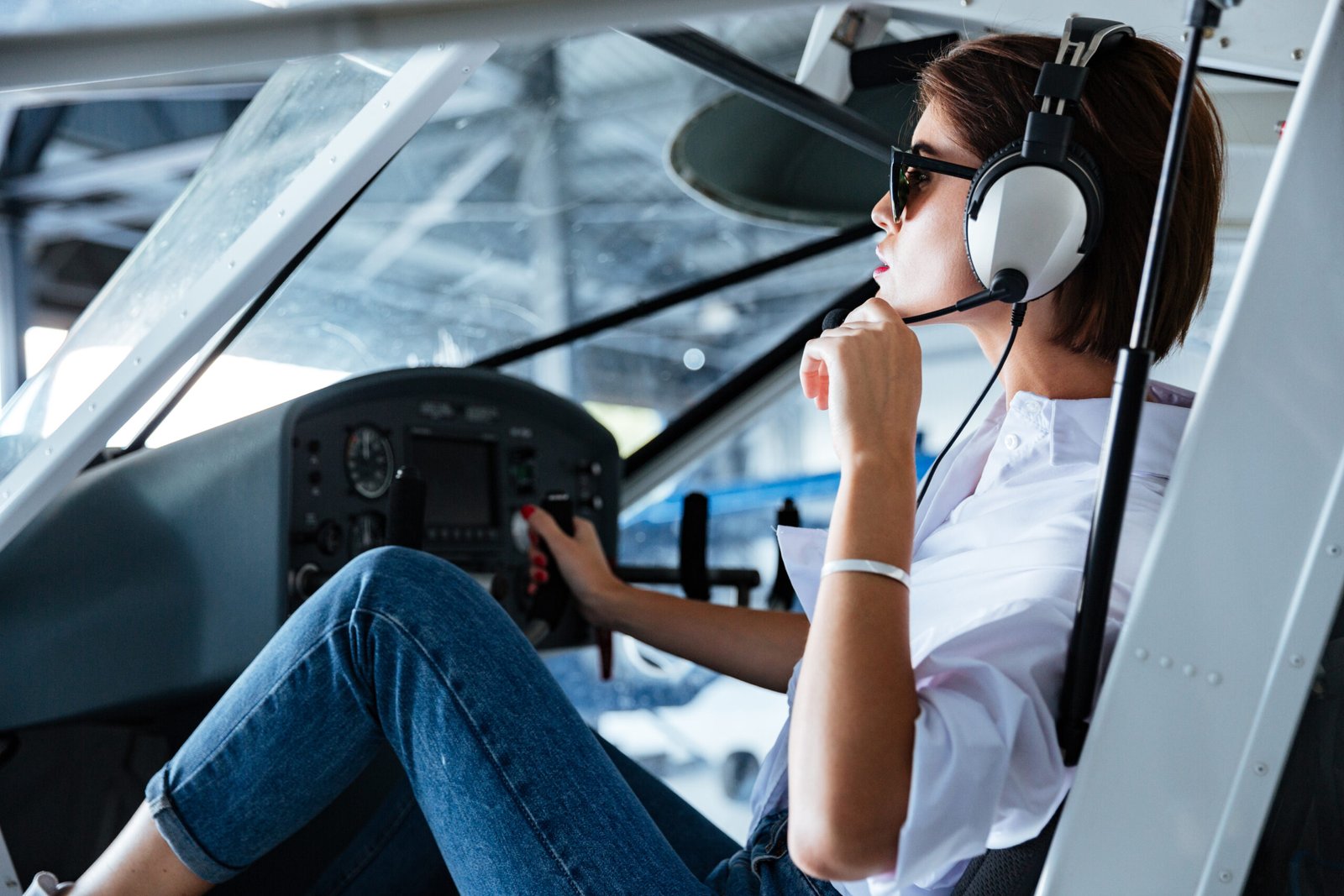Aerospace Engineering
The Evolution of Aviation: From Wright Flyers to Modern Jets
Aviation has come a long way since the Wright brothers took to the skies in 1903 with their iconic Flyer. Today, we find ourselves in an exhilarating era where technology and innovation are reshaping how we fly, learn, and explore the vast expanse of our skies. As we delve into this evolution, let’s explore online aviation courses, career opportunities for pilots, the rise of drones, and the vital role of technology in training.
With the convenience of digital education, aspiring aviators can now enroll in various online aviation courses. These platforms offer flexible learning schedules that cater to busy individuals who aspire to soar through the clouds. Ground schools have also taken a leap forward; combining traditional classroom teachings with interactive e-learning modules allows students to grasp complex concepts quickly. The comprehensive curriculum covers everything from aerodynamics to regulations set forth by the Federal Aviation Administration (FAA), preparing students for real-world challenges.

Once grounded knowledge is achieved, many dreamers transition into thrilling careers as pilots. The job market for pilots has seen fluctuations over recent years but remains vibrant due to increasing demand from airlines and cargo companies. According to industry forecasts, more than 700,000 pilots will be needed globally within the next two decades! This robust demand offers a wealth of opportunities—from commercial airline operations to specialized fields like agricultural aviation or aerial firefighting.
Equally fascinating is the emergence of drones—a game changer in both recreational and professional spheres. Unmanned Aerial Vehicles (UAVs) have transformed industries such as delivery services, agriculture monitoring, and even cinematography. With developments advancing at lightning speed, FAA regulations around drone usage are evolving too. Pilots looking to operate drones commercially must obtain a Remote Pilot Certificate which ensures that safety protocols are upheld in increasingly crowded airspace.
For those seeking insights into this dynamic world of aviation beyond formal education and jobs, numerous blogs and websites serve as excellent resources. Some popular choices include “Airline Reporter,” which provides updates on airline news; “Flight Global,” offering industry analysis; or “AOPA” (Aircraft Owners and Pilots Association), which supports general aviation enthusiasts with news and advocacy efforts. On social media platforms like Instagram or Twitter, hashtags such as #aviationlovers or #pilotlife connect enthusiasts worldwide—sharing breathtaking photos and stories that inspire new generations of aviators.
As technology continues its relentless march forward, so does training methodology within aviation. Flight simulators have become indispensable tools for pilot training programs across various levels—offering realistic experiences without leaving solid ground. These advanced simulators replicate flight conditions accurately while enabling trainees to practice emergency procedures safely—a crucial aspect when preparing them for actual flights.
In summary, the evolution of aviation is not only about moving from wooden biplanes to sleek jets but also reflects a profound shift in education methods and career pathways available today. Online courses make learning accessible; ground schools blend tradition with modernity; drones redefine roles within aviation; while blogs unite passionate individuals eager to share their love for flying—all underscored by cutting-edge training technologies like simulators that ensure preparedness for whatever skies await ahead! Whether you’re dreaming of becoming a pilot or simply captivated by aircraft flying overhead—this ever-evolving narrative continues unfolding before our eyes!

Flight Innovations: How Technology is Transforming the Aviation Industry
The aviation industry stands on the precipice of a technological revolution. With advancements unfolding at an unprecedented pace, aspiring pilots and aviation enthusiasts have more opportunities than ever before to explore their passions. From online courses to vibrant communities, technology is reshaping the landscape of aviation education and career paths.
One of the most significant game-changers in recent years has been the rise of online aviation courses. No longer confined to traditional ground schools, prospective pilots can now access comprehensive training programs from anywhere in the world. These virtual platforms offer a variety of subjects—from navigation and meteorology to human factors and aircraft systems—often taught by seasoned professionals with decades of experience. This accessibility fosters a new generation of aviators who can learn at their own speed while balancing other commitments.
Ground schools are evolving as well, blending face-to-face instruction with digital resources. Students benefit from interactive simulations that replicate real-world flying scenarios, enhancing their understanding and retention of complex material. Additionally, many institutions are integrating augmented reality (AR) and virtual reality (VR) technologies into their curriculum, providing immersive experiences that prepare students for actual flight conditions.
As more individuals equip themselves with knowledge through these innovative platforms, they also become part of an expanding job market for pilots. The demand for qualified aviators continues to rise globally due to increasing air travel and the retirement of seasoned professionals. Airlines are actively seeking fresh talent; thus, completing a reputable course can significantly enhance one’s employability. Many programs even include internship opportunities or partnerships with airlines, offering students invaluable networking potential right out of school.

Beyond formal education channels, aspiring pilots and aviation aficionados can find camaraderie in various online forums and communities dedicated to all things aviation. Websites like AOPA (Aircraft Owners and Pilots Association) provide invaluable resources ranging from regulatory updates to safety tips while fostering connections among members through discussion boards. Other platforms such as PPRuNe (Professional Pilots Rumour Network) allow experienced pilots to share insights about the industry’s latest trends or engage in light-hearted banter about flying quirks.
Social media has further transformed how members within this community interact. Groups on Facebook cater specifically to pilot discussions—ranging from sharing flight stories to discussing gear—and often serve as support networks during challenging times in training or career transitions. Instagram accounts dedicated to stunning aerial photography give followers a glimpse into life above the clouds while inspiring others to take flight themselves.
For those eager for curated content about aviation trends or personal experiences shared by fellow aviators, several blogs and websites stand out:
1. **AirlineReporter.com** – Focused on airline products and services.
2. **TheAviationist.com** – Features military aviation news and analysis.
3. **FlyingMag.com** – A go-to resource for general aviation enthusiasts.
4. **PilotInstitute.com** – Offers extensive guides on becoming a pilot.
5. **FlightGlobal.com** – Provides comprehensive coverage on global aerospace developments.
Additionally, following specific hashtags like #AvGeek or #PilotLife on platforms like Twitter can lead you down exciting rabbit holes filled with captivating stories from fellow enthusiasts.
In conclusion, technology is not merely improving how we fly but redefining how we learn about aviation altogether. From versatile online courses that democratize access to knowledge, nurturing supportive communities online, or engaging with vibrant blogs—there’s never been a better time for anyone interested in taking wing into this thrilling world!
Unmasking the Mysteries of Flight: How Airplanes Really Work
Aviation has long captivated our imaginations, from the first daring flights of the Wright brothers to today’s colossal jetliners soaring through the skies. But have you ever wondered how these marvels of engineering actually work? Beyond the awe-inspiring takeoffs and landings lies a world rich with knowledge that can be explored through various avenues, such as online aviation courses, ground schools, and vibrant aviation communities.
For those eager to dive deeper into the mechanics of flight, online aviation courses are an excellent starting point. These courses cover everything from fundamental aerodynamics to advanced navigation techniques. They cater not only to aspiring pilots but also to enthusiasts looking to understand the intricacies of aircraft systems. Platforms like Coursera and Udemy offer structured learning paths led by industry professionals who share their insights and experiences. Through interactive modules and video lectures, students can gain a solid grounding in aviation principles at their own pace.
Ground schools serve as another invaluable resource on this journey toward becoming a pilot or simply understanding aviation better. These schools often provide both classroom instruction and practical training in flight simulators. Whether in-person or virtual, ground school programs cover essential topics such as weather conditions, regulations, and emergency procedures—knowledge crucial for every aviator. Enrolling in a reputable ground school not only fosters technical skills but also instills confidence in navigating complex flying scenarios.

With proper education comes opportunity! The realm of aviation offers diverse career paths for those passionate about flying. Becoming a pilot is perhaps one of the most sought-after professions; however, it’s worth noting that there are numerous roles within this industry—from air traffic controllers to maintenance technicians and flight engineers. As commercial air travel continues to expand globally, so does the demand for qualified personnel across various sectors within aviation.
Engaging with fellow enthusiasts can significantly enhance your understanding of flight mechanics too! Aviation forums and communities like PPRuNe (Professional Pilots Rumour Network) or AvGeek groups on Reddit serve as platforms where individuals share experiences, insights, tips, and advice about all things airborne. These forums create a sense of camaraderie among pilots and hobbyists alike—offering support during training or sharing stories from thrilling flights around the world.
If you’re seeking even more resources to fuel your passion for aviation, numerous blogs and websites provide endless information on current events within the field alongside technical knowledge. Some popular blogs include “AirlineReporter,” which covers airline industry news with an engaging twist; “The Flying Engineer,” focusing on engineering aspects; or “Flight Chic,” which explores fashion within air travel culture.
Social media platforms also play a pivotal role in connecting aviators globally. On Instagram alone, hashtags like #AvGeek or #PilotLife showcase stunning photographs from cockpit views to breathtaking aerial shots that inspire wanderlust among followers. Twitter is another great avenue for real-time updates from industry experts while YouTube channels dedicated to aviation documentaries offer visually captivating narratives that unravel complex concepts behind aircraft functionality.
In conclusion, whether you’re dreaming of becoming a pilot or simply intrigued by what makes airplanes soar through clouds effortlessly—there’s no shortage of resources available today! From online courses that educate aspiring aviators to interactive forums fostering community engagement, each aspect unravels layers upon layers of knowledge waiting for exploration in this fascinating domain called aviation!


